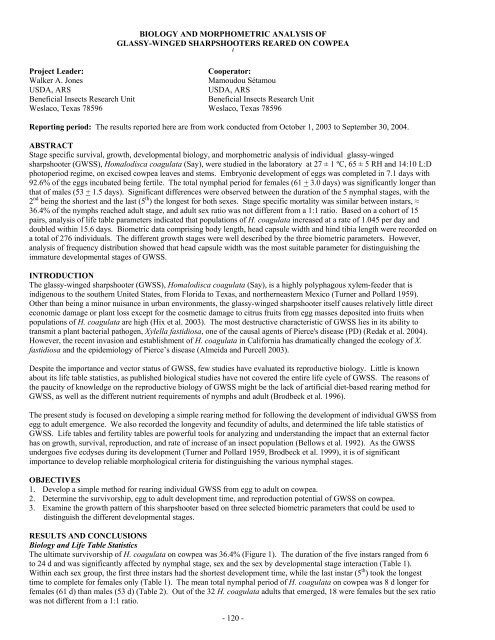Impact Of Host Plant Xylem Fluid On Xylella Fastidiosa Multiplication ...
Impact Of Host Plant Xylem Fluid On Xylella Fastidiosa Multiplication ...
Impact Of Host Plant Xylem Fluid On Xylella Fastidiosa Multiplication ...
Create successful ePaper yourself
Turn your PDF publications into a flip-book with our unique Google optimized e-Paper software.
BIOLOGY AND MORPHOMETRIC ANALYSIS OF<br />
GLASSY-WINGED SHARPSHOOTERS REARED ON COWPEA<br />
i<br />
Project Leader:<br />
Walker A. Jones<br />
USDA, ARS<br />
Beneficial Insects Research Unit<br />
Weslaco, Texas 78596<br />
Cooperator:<br />
Mamoudou Sétamou<br />
USDA, ARS<br />
Beneficial Insects Research Unit<br />
Weslaco, Texas 78596<br />
Reporting period: The results reported here are from work conducted from October 1, 2003 to September 30, 2004.<br />
ABSTRACT<br />
Stage specific survival, growth, developmental biology, and morphometric analysis of individual glassy-winged<br />
sharpshooter (GWSS), Homalodisca coagulata (Say), were studied in the laboratory at 27 ± 1 ºC, 65 ± 5 RH and 14:10 L:D<br />
photoperiod regime, on excised cowpea leaves and stems. Embryonic development of eggs was completed in 7.1 days with<br />
92.6% of the eggs incubated being fertile. The total nymphal period for females (61 + 3.0 days) was significantly longer than<br />
that of males (53 + 1.5 days). Significant differences were observed between the duration of the 5 nymphal stages, with the<br />
2 nd being the shortest and the last (5 th ) the longest for both sexes. Stage specific mortality was similar between instars, ≈<br />
36.4% of the nymphs reached adult stage, and adult sex ratio was not different from a 1:1 ratio. Based on a cohort of 15<br />
pairs, analysis of life table parameters indicated that populations of H. coagulata increased at a rate of 1.045 per day and<br />
doubled within 15.6 days. Biometric data comprising body length, head capsule width and hind tibia length were recorded on<br />
a total of 276 individuals. The different growth stages were well described by the three biometric parameters. However,<br />
analysis of frequency distribution showed that head capsule width was the most suitable parameter for distinguishing the<br />
immature developmental stages of GWSS.<br />
INTRODUCTION<br />
The glassy-winged sharpshooter (GWSS), Homalodisca coagulata (Say), is a highly polyphagous xylem-feeder that is<br />
indigenous to the southern United States, from Florida to Texas, and northerneastern Mexico (Turner and Pollard 1959).<br />
Other than being a minor nuisance in urban environments, the glassy-winged sharpshooter itself causes relatively little direct<br />
economic damage or plant loss except for the cosmetic damage to citrus fruits from egg masses deposited into fruits when<br />
populations of H. coagulata are high (Hix et al. 2003). The most destructive characteristic of GWSS lies in its ability to<br />
transmit a plant bacterial pathogen, <strong>Xylella</strong> fastidiosa, one of the causal agents of Pierce's disease (PD) (Redak et al. 2004).<br />
However, the recent invasion and establishment of H. coagulata in California has dramatically changed the ecology of X.<br />
fastidiosa and the epidemiology of Pierce’s disease (Almeida and Purcell 2003).<br />
Despite the importance and vector status of GWSS, few studies have evaluated its reproductive biology. Little is known<br />
about its life table statistics, as published biological studies have not covered the entire life cycle of GWSS. The reasons of<br />
the paucity of knowledge on the reproductive biology of GWSS might be the lack of artificial diet-based rearing method for<br />
GWSS, as well as the different nutrient requirements of nymphs and adult (Brodbeck et al. 1996).<br />
The present study is focused on developing a simple rearing method for following the development of individual GWSS from<br />
egg to adult emergence. We also recorded the longevity and fecundity of adults, and determined the life table statistics of<br />
GWSS. Life tables and fertility tables are powerful tools for analyzing and understanding the impact that an external factor<br />
has on growth, survival, reproduction, and rate of increase of an insect population (Bellows et al. 1992). As the GWSS<br />
undergoes five ecdyses during its development (Turner and Pollard 1959, Brodbeck et al. 1999), it is of significant<br />
importance to develop reliable morphological criteria for distinguishing the various nymphal stages.<br />
OBJECTIVES<br />
1. Develop a simple method for rearing individual GWSS from egg to adult on cowpea.<br />
2. Determine the survivorship, egg to adult development time, and reproduction potential of GWSS on cowpea.<br />
3. Examine the growth pattern of this sharpshooter based on three selected biometric parameters that could be used to<br />
distinguish the different developmental stages.<br />
RESULTS AND CONCLUSIONS<br />
Biology and Life Table Statistics<br />
The ultimate survivorship of H. coagulata on cowpea was 36.4% (Figure 1). The duration of the five instars ranged from 6<br />
to 24 d and was significantly affected by nymphal stage, sex and the sex by developmental stage interaction (Table 1).<br />
Within each sex group, the first three instars had the shortest development time, while the last instar (5 th ) took the longest<br />
time to complete for females only (Table 1). The mean total nymphal period of H. coagulata on cowpea was 8 d longer for<br />
females (61 d) than males (53 d) (Table 2). Out of the 32 H. coagulata adults that emerged, 18 were females but the sex ratio<br />
was not different from a 1:1 ratio.<br />
- 120 -











